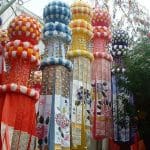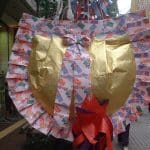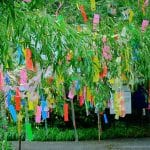This blog post is brought to you by Paige C., Flowing Wells Library.
Tanabata (七夕, たなばた), or the Star Festival, occurs every year on the seventh day of the seventh month. What this means may differ depending on where you are in Japan. For some, this is according to the Gregorian calendar, which sets the festival on July 7. In other places, the lunar calendar is followed, so the festival falls on August 7. The kanji for Tanabata translates into “the night of sevens” and so the number seven is particularly important.
Tanabata originates from the Chinese Qixi Festival, which centers on the legend of Altair and Vega (Hikoboshi and Orihime in Japanese), two stars in the Aquila and Lyra constellations. The Japanese version of the legend goes that Hikoboshi, the cow herder, and Princess Orihime, the weaver, were very skilled at their work. However, the two met and fell so in love they ignored their duties and angered the gods. As punishment they were forced to forever be separated by the Milky Way. However, every year on the seventh day of the seventh month they are allowed to meet once again.
To celebrate the meeting of the two, wishes are written on long strips of colorful paper called tanzaku (短冊, たんざく) and are hung on a bamboo tree. In some festivals, the day after the trees are decorated they are floated out on water and burned as an offering to help the wishes come true.
One of the largest and most popular festivals is in Sendai, located northeast of Tokyo. Sendai’s Tanabata festival takes place August 6–8 and is famous for what is called ‘nanatsu kazari’ (七つ飾り, ななつかざり) or ‘seven decorations.’ These decorations, made of paper and crafted for the festival, are tanzaku, fukinagashi, kinchaku, orizuru, toami, kuzukago, and kamigoromo.
- Tanzaku (短冊, たんざく) are, as mentioned earlier, colorful strips of paper that wishes are written upon. People write wishes and messages of thanks. Traditionally, these wishes were for academic success – but these days they can be for anything!
- Fukinagashi (吹き流し, ふきながし) are colorful windsocks that are made to honor the beautiful fabric created by the weaver Orihime.
- Kinchaku (巾着, きんちゃく) are drawstring purses. The ones for Tanabata are made from paper with wishes for both economic and mental wealth.
- Orizuru (折り鶴, おりづる) are paper cranes folded and hung as colorful streamers for longevity.
- Toami (投網, とあみ) are fishing nets made and hung up to bring good harvest and good fishing.
- Kuzukago (屑籠, くずかご) are trash nets that symbolize cleanliness and thriftiness.
- Kamigoromo (紙衣, かみごろも) are paper kimonos made to symbolize improving sewing skills and to ward off bad health.
While many of these decorations are mostly associated with Sendai’s Tanabata festival, it is not uncommon to see them at other Star Festivals around Japan and even the world. One of the largest Tanabata festivals is actually located in São Paulo, Brazil at the beginning of July. Another festival is in Los Angeles, California, this year from August 13 through August 21, 2022.
Tanabata is a festival full of colors and wishes, with an array of paper crafts that can be done to usher in good fortune in many aspects of life. What will you wish for?
Crafts for Tanabata:
- Here’s a video on tanzaku.
- Follow this tutorial for a fukinagashi.
- Check out this easy tutorial for orizuru.
- Find tutorials for all of the Tanabata decorations!







